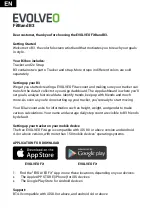
USER'S MANUAL
CAN bus LCD Display
TRI66.003 ver 2
10 April 2011
5
MOUNTING
The LCD display can be mounted using double-sided adhesive tape to hold it into
position in a cutout in a flat panel. The display itself is lightweight, although the
CAN cable may present some load and may require strain relief elsewhere on the
panel.
The display requires a rectangular mounting hole cutout of 60 x 40mm, with
panel thicknesses of up to 1.5mm.
6
PROGRAMMING
6.1
OVERVIEW
The LCD display is based around a Texas Instruments (TI) MSP430 16-bit
embedded low-power microcontroller, operating from a clock derived from a
multiplied 32.768kHz watch crystal as default. CAN bus support is provided via a
Microchip MCP2515 CAN controller and TI SN65HVD234 CAN transceiver. The
display is not isolated from the CAN network.
6.2
SCHEMATICS & SOURCE CODE
Schematics and PCB component position overlays in PDF format are available for
download on the Tritium website. A zip file is also provided containing the
default source code for the microcontroller, written in 'C' and available under a
BSD open-source license.
Please refer to these references if developing custom firmware for the display.
6.3
TOOLCHAIN
The example default code provided is configured to work with the freely-available
open-source MSP430 GCC toolchain, which provides a command-line driven
compiler, binutils, download, and real-time debug capability through a JTAG
header present on the back of the display PCB. Please refer to the README file
with the source code for download and installation instructions.
An adapter is provided with every display product that converts the TI standard
14-pin JTAG debug header to the smaller 8-pin flexible printed circuit (FPC)
header used on Tritium devices. Tritium recommends the use of the USB
programmer part number MSP-FET430 UIF available from TI or their distributors,
although lower cost and slower performance parallel-port devices are also
useable.
6.4
CODE DOWNLOAD
Connect the 8-pin FPC ribbon to the header on the display PCB, with the Pin 1
indication arrows matching on both the display and the adapter board.
Follow the instructions in the README file to compile your 'C' source, produce an
object file for loading into the microcontroller, and download the new firmware to
flash memory in the microcontroller. Please feel free to email any questions or
comments to James Kennedy, [email protected].
6 of 7

























